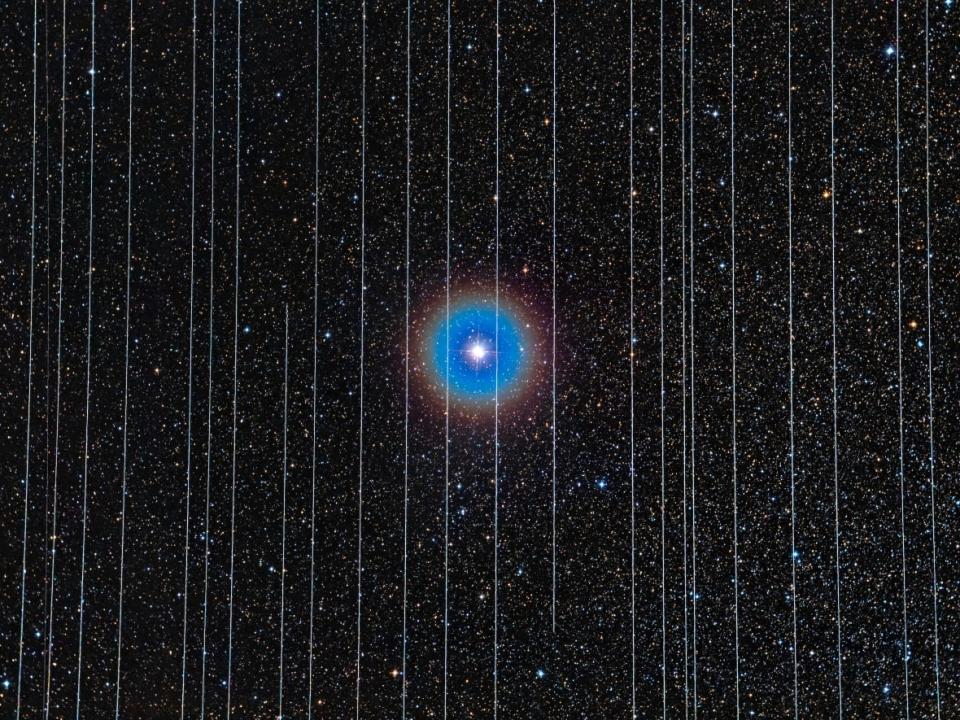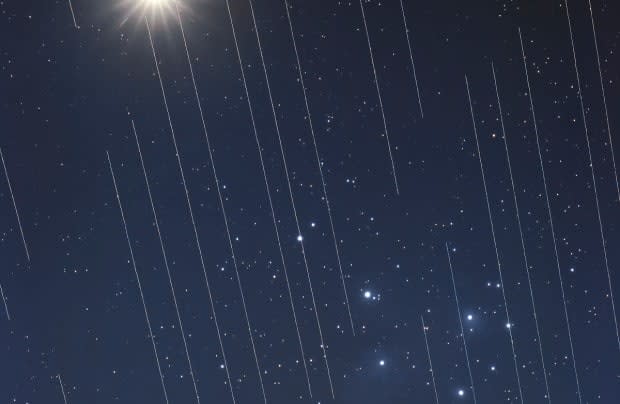Is the night sky part of our natural environment? Some astronomers say yes, and are trying to preserve it

Astronomer Samantha Lawler walked out of her farmhouse in Edenwold, about 30 kilometres northeast of Regina, her feet crunching on the snow below, the cacophony of ducks and chickens emanating from her barn.
It was early morning, before sunrise, and the stars were still draped across the sky.
She glanced up on her short walk and noticed the slow movement of light among the stars. Then another. And another. She eventually stopped counting.
Lawler knew all too well what those faux-stars were: satellites.
"I wasn't even staring at the sky. I was just looking and walking between buildings and I saw a dozen in like a minute of looking up," she said. "I mean, it's really bad. It's quite noticeable."
And it's about to get a lot worse.
Astronomers around the world are concerned about a handful of commercial companies — chiefly SpaceX — proposing to flood low-Earth orbit with tens of thousands of these satellites, with the potential to far exceed that. There's also the risk of satellites crashing into one another and adding to the thousands of pieces of space junk already in orbit.
All this, astronomers say, is a threat to the preservation of our night sky.

As a result, on Feb. 3, the International Astronomical Union (IAU) announced the formation of the Center for the Protection of the Dark and Quiet Sky from Satellite Constellation Interference. Their goal is clear: to work with industry leaders, amateur astronomers, Indigenous groups and scientists around the world to protect the sanctity of the night sky.
So far, there has been little to no disagreement between astronomers and industry leaders.
"The experience we've had in interacting with industry is that they've been exceedingly co-operative in trying to deal with their individual objects and how much light they scatter," said Richard L. Green, an astronomer at the University of Arizona who is part of the executive committee working group on the protection of the skies.
But that could change.
"There's always a caveat, because [industry] can only do so much," said Connie Walker, co-director of the new centre, and an astronomer with the National Science Foundation's National Optical-Infrared Astronomy Research Laboratory (NOIRLab).
"They're there to turn a profit. But I do think we have their ear, especially at this point in time. And I do think there is authentic good will, in trying to do as much as they can. But that has limits."
That's why some astronomers are suggesting that society as a whole needs to act pre-emptively and consider our skies, and low-Earth orbit, part of our natural environment, and worth preserving.
Deeper concerns over the environment
The night sky has been a driving force in human history. We used the stars to navigate, to help us decide when to plant and to record time. We tracked the planets and noted when a new "star" (a supernova explosion) appeared in the heavens.
But nowadays, the Milky Way is something most people have only seen in photographs or on TV. A 2018 study found that the Milky Way is hidden from roughly one-third of humanity, including 80 per cent of North Americans.

But there's another issue that concerns Lawler, one that doesn't involve the night sky.
Starlink satellites, which are providing broadband internet access to rural locations, have a life expectancy of roughly five years, after which they will be de-orbited and burn up in Earth's atmosphere.
"If you do the calculation, they want to replace 42,000 satellites every five years," said Lawler, who wrote an assessment on constellations for the federal government. "That means they'll be de-orbiting 23 a day. When you just look at the mass of them, they're like car-sized, right? So, that comes to six tonnes, of aluminum mostly, that will be added to the upper atmosphere every single day."
Why does that matter?
In the fight against climate change, the injection of alumina particles into the upper atmosphere has been proposed to help cool the planet, but the wider implications are not yet well understood.
"Low-Earth orbit is not legally considered an environment," Lawler said. "So nobody's looking at this."
There's also another way to look at it: how these satellites are impacting cultures who have relied on the stars throughout history.
"You could go as far as saying, well, you know, the Truth and Reconciliation Commission's Calls to Action talk about how if a private company is going to take resources away from Indigenous people, they need to be consulted and give permission and be compensated," Lawler said. "Does this count? Having a private company make a profit by destroying a resource that they've had access to for thousands of years?"
Some efforts being made
Satellites are responsible for so much in our day-to-day lives, from global positioning systems that help us get around to weather satellites to Earth-monitoring satellites.
According to the European Space Agency's Space Debris Office, as of Jan. 5, there are roughly 7,840 satellites in orbit, with about 5,100 still operational.
However, in the 65 years since the Soviet Union launched Sputnik — the first artificial satellite — many satellites are now in the hands of commercial industry, with little regulation.
And SpaceX is leading the charge. To date, the company has launched roughly 2,000 Starlink satellites aimed at providing internet access to even the most remote parts of the globe, with plans to launch upwards of 42,000.
But there are also other players, including Jeff Bezos's Amazon/Project Kuiper, Europe's OneWeb and Canada's own Telesat.
WATCH | Future satellite simulations from Canada/Europe at the summer solstice. Yellow points are the brightest satellites, blue are the faintest:
There are even websites, such as SatelliteMap.Space, where you can track SpaceX and OneWeb satellites in real time and determine when they will pass overhead. ESRI has developed a beta website that allows viewers to see the amount of space debris and satellites in orbit.
There are also dedicated apps, such as Mega Constellations, developed by Canadian astronomer Hanno Rein. (The ESA has calculated that there are currently more than one million pieces of debris measuring 1-10 cm that can pose a danger to satellites and astronauts.)
When the first batch of Starlinks was launched in 2019, both astronomers and industry leaders were surprised to see just how bright the train of satellites was. (SpaceX initially launches them to roughly 200 km in altitude, before deploying them to around 500 km.)
The company was quick to respond to astronomers' complaints and sought to reduce their reflectivity — first with paint, and then with a type of shield. While this helped, it didn't eliminate the problem.
WATCH | Amateur astronomer Alan Dyer captures Starlink satellites from southern Alberta in 2019:
OneWeb, which initially sought to launch nearly 48,000, slashed its proposal down to roughly 6,400 satellites.
It's all a move in the right direction, astronomers say.
"I think we bought some time because Starlink did agree to a higher [orbit] and OneWeb significantly reduced the total number of their satellites," said Jonathan McDowell, an astronomer at Harvard University's Astrophysics Center, who also took part in the working groups of the IAU.
"So that, I think, is going to keep the astronomy impact in the next few years to super-annoying, rather than fatal."
Lawler doesn't necessarily share that optimism.
"There are a lot of engineering problems that I think [industry] could rise to the challenge [of], but they're just not seeing them, they're only seeing the bare minimum to make the most money," she said. "And that's all that they're focused on. The consequences of that are that we could lose the ability to use orbit safely, in addition to destroying the sky and the atmosphere."
SpaceX did not respond to an interview request. Telesat was not available to speak with CBC News at the time of publication.
A strain on science
When it comes to astronomy — most of which is supported through public funds — reducing the brightness or altitude isn't quite enough.
When astronomers collect data, they're often taking long-exposure photographs, sometimes of the entire sky. Even though satellites at a higher altitude may be invisible to the naked eye, they are picked up by large telescopes, and appear as long streaks in these images.
McDowell, who is currently working on algorithms to help astronomers deal with these satellites in images, said it's not as simple as using software to eliminate the streaks.
WATCH | Starlinks cross over the Cerro Tololo Inter-American Observatory in 2020:
"People will tell us, 'Oh, no big deal. You just use Photoshop and wipe out the streak, right?'" McDowell said. "Well, no, because we're trying to measure the brightness of stars to, like, one per cent. So that doesn't work."
Then there's the potential impact to radio astronomy.
Canada is a partner in the Square Kilometre Array Observatory (SKAO) in South Africa, where 197 radio astronomy dishes will together become the largest radio astronomy dish in the world. It is a radio-quiet zone where not even cell phones are allowed.
However, satellite constellations threaten the observatory, which will open at the end of the decade. A recent analysis by SKAO suggests that they could lose a significant amount of sensitivity to some molecules, impacting their research.
The new IAU centre is still in its infancy, but it has big goals. It has held several working groups on the issue, is developing industry standards and is working with the United Nations' Committee on the Peaceful Uses of Outer Space.
McDowell said that it's about addressing the problem now, before it's too late.
"As is always the case with environmental problems, it's that nothing happens until it's really bad," he said. "And then people go, 'Oh, I suppose we should do something.'"

